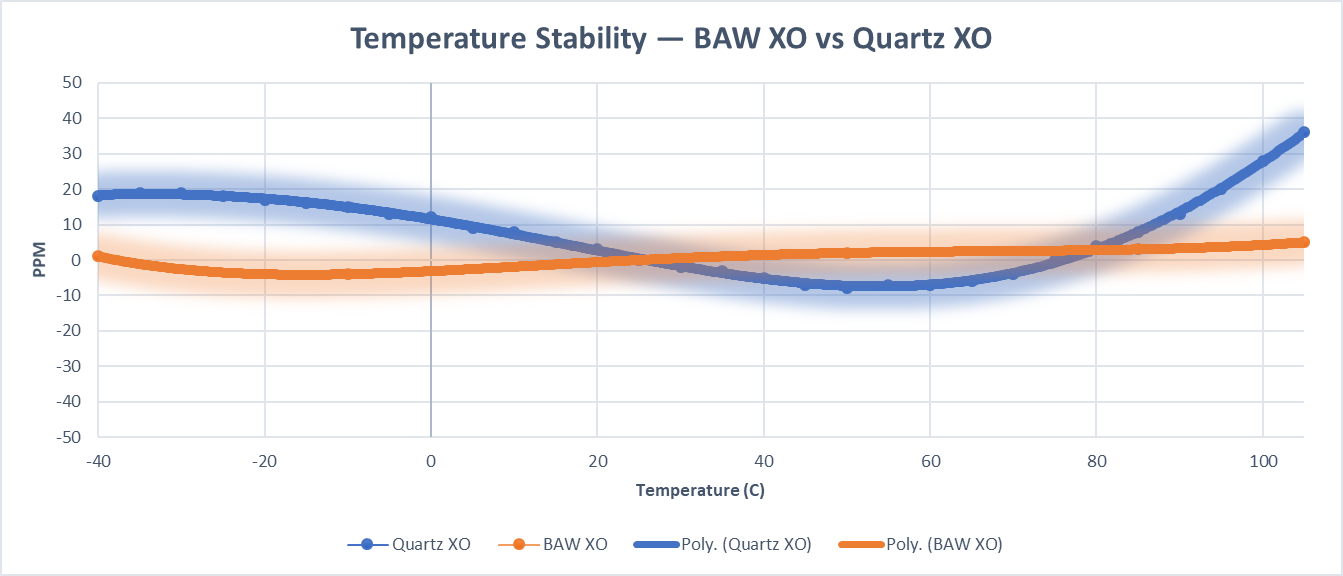SNAA369 November 2022 LMK6C , LMK6D , LMK6H , LMK6P
BAW Oscillator Solutions for Optical Modules
BAW Resonator Technology
BAW is a micro-resonator technology that enables the integration of high-precision and ultra-low jitter clocks directly into packages that contain other circuits. In the BAW oscillator, the BAW resonator is intergated with a collocated precision temperature sensor, a ultra-low jitter, low power fractional output divider (FOD), a single-ended LVCMOS (LMK6C) and differential LVPECL (LMK6P), LVDS (LMK6D), and HCSL (LMK6H) output driver, and a small power-reset-clock management system consisting of several low noise LDOs.
Figure 1-1 shows the structure of the the BAW resonator technology. The structure includes a thin layer of piezoelectric film sandwiched between metal films and other layers that confine the mechanical energy. The BAW resonator utilizes this piezoelectric transduction to generate a vibration.
 Figure 1-1 Basic Structure of a Bulk
Acoustic Wave (BAW) Resonator
Figure 1-1 Basic Structure of a Bulk
Acoustic Wave (BAW) ResonatorBAW Oscillator in Optical Modules
The BAW oscillator can be used as a drop-in replacement for standard oscillators in many existing optical module systems. The 125 fs maximum jitter performance in the differential variants (LMK6P/D/H) allows the BAW to be used in high-speed optical applications up to 800G. Figure 1-3 showcases BAW oscillator phase noise performance at 156.25 MHz. The internal fractional output divider allows the LMK6 family to generate any output frequency between 1 - 400 MHz. The most commonly used frequencies in optical modules (156.25 MHz, 161.1328125 MHz, 312.5 MHz, 322.265625 MHz, and so forth) are fully supported.
Figure 1-2 shows a typical block diagram for an optical module system. The BAW oscillator is primarily used to clock the integrated SerDes in the PAM4 DSP. Here, high performance clocking is needed to ensure data integrity is maximized. The BAW oscillator can also be used for other clocking needs throughout the entire system due to its flexibility in frequency, format, and voltage levels. The BAW oscillator is fully pin-compatible with the majority of high-performance oscillators in the market today.
Benefits of the BAW Oscillator
Ultra-low Jitter Performance
The differential output variants in the LMK6 family offer 125 fs maximum jitter, making it the ideal choice for 800G optical networks and other high-performance applications. Additionally, the LMK6H meets all PCIE Gen 1-6 requirements with the HCSL output stage. In designs where HCSL is not required, the LMK6C/P/D meets all PCIE Gen 6 jitter requirements.
 Figure 1-3 BAW Oscillator 156.25 MHz
Phase Noise Performance (Normalized spur mode)
Figure 1-3 BAW Oscillator 156.25 MHz
Phase Noise Performance (Normalized spur mode)Flexible Solution
The LMK6 family can generate any output frequency between 1 MHz and 400 MHz in 4 possible output formats (LVCMOS, LVPECL, LVDS, and HCSL) with 1.8 V, 2.5 V, or 3.3 V supply voltages. DLE (3.2 mm x 2.5 mm) and DLF (2.5 mm x 2 mm) packages are available to save space in compact board designs. LMK6 BAW oscillators only require a single capacitor for power supply filtering, while crystal oscillators may require up to four external components.
 Figure 1-4 PCB Footprint Comparison
Between BAW and Crystal Oscillators
Figure 1-4 PCB Footprint Comparison
Between BAW and Crystal OscillatorsHigh Grade Reliability
The BAW oscillator is tolerant to temperatures up to 105°C and features a 20 - 30 higher Mean Time Before Failure (MTBF) than competing crystal oscillator solutions. Throughout its lifetime, the BAW oscillator has an ensured frequency stability of ±25 ppm, inclusive of all aging and environmental factors. Over temperature, the BAW oscillator has a ±10 ppm frequency stability that is significantly better than current quartz-based oscillators.
 Figure 1-5 BAW Oscillator vs. Quartz XO:
Frequency Stability Over Temperature
Figure 1-5 BAW Oscillator vs. Quartz XO:
Frequency Stability Over Temperature